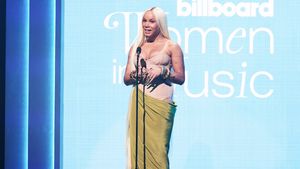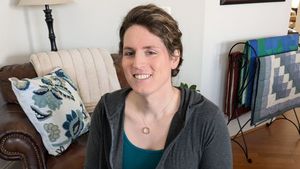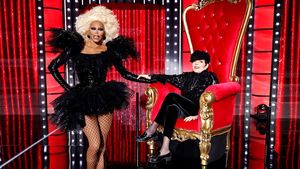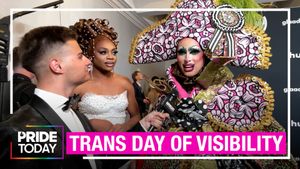As part of our effort to profile more authors within the LGBT community, we present Diana Cage.
Author, editor, blogger, and media personality Cage is the former host of The Diana Cage Show, a wildly popular, no-holds-barred nightly talk show on Sirius XM. Her books include Girl Meets Girl: A Dating Survival Guide, Box Lunch: The Layperson’s Guide to Cunnilingus, Bottoms Up: Writing About Sex, and the groundbreaking On Our Backs Guide to Lesbian Sex.
Cage served as editor of On Our Backsmagazine, the only sex magazine made by and for women, for five years. She has been featured in dozens of publications, including the San Francisco Chronicle, Xtra magazine, Time Out New York, The Bay Area Guardian, Maxim, Bitch, Curve, and Girlfriends, and was named one of GO Magazine's "100 Women We Love" in 2008. She is featured in seasons one and two of the Here! Television series Lesbian Sex and Sexuality, and has appeared on HBO’s Real Sex and Showtime’s Family Business, as well as on Channel Jimmy in Italy and on Sex TV in Canada.
Cage lives in Philadelphia and holds an MFA from San Francisco State University. She currently speaks about sex and sexuality at top colleges and universities around the country.
The following is excerpted from Mind-Blowing Sex: A Woman's Guide by Diana Cage. Available from Seal Press, a member of the Perseus Books Group. Copyright 2012.
RETHINKING SEX
I feel like I’m always learning about sex. I read about it, write about it, talk about it at conferences, and, of course, have as much of it as I can, and I am constantly surprised by the amount of new information I encounter. Funny how much there is we don’t know, when sex has been around as long as we have, and that’s what? Four million years? Part of my job, as I’ve come to discover, is separating useful information from information that further obfuscates what we need to know to have fantastic sex lives. I enjoy thinking, talking, and writing about sex almost as much as I love having it. And not just the mechanics of sex—I also enjoy thinking, talking, and writing about sexuality, gender, culture, and society. I’ve spent my life combining those things. I know that my desire to understand who I am in this world as a woman and a sexual person, combined with my eagerness to master sexual techniques, is what makes me a good lover.
I believe that good sex requires an open mind, a willingness to listen and learn, and practical skills. This book is neither a thorough discussion of feminism nor an exhaustive list of bedroom skills. Instead, it’s an introduction to the idea that the two things complement each other. Sex-positive feminism is something we’re already familiar with. What I hope to provide you with is feminism-positive sex.
SEXUALITY IS CULTURE
What we think we understand about sex and sexuality has changed over time, and is still changing rapidly. Our sexuality is a cultural phenomenon, meaning that while our drive to have sex may be innate, the way we express ourselves sexually—for instance, the type of sex we desire, and what we consider erotic or taboo—changes based on the culture we live in. A lot of current thinking on sexuality still tells us that women are less sexual than men and are by nature heterosexual and monogamous. This thinking about female sexuality is rooted in a very sexist notion that females don’t desire sex as much as men, and instead, being naturally powerless, use it as a form of currency.
For instance, many popular theories about female sexuality and infidelity purport that females, being less able to fend for themselves, have evolved to offer sex to multiple partners on the sly in exchange for things their partner can bring them, like food and protection. These are ideas we’ve constructed as a society because they reinforce the power of the dominant culture and have been upheld so strongly over time that they now seem as if they are part of our biological makeup.
We’re in a period where it is very popular for science to link gender differences with biological differences in the brains of males and females. This is why contemporary sex and relationship advice centers on helping individuals understand “the opposite sex.” Men are from Mars, women are from Venus, etc. We can’t know for sure, though, that the development of our brains isn’t somehow affected by our socialization as male or female. If the female brain is better designed for communication and empathy, as theories claim, and the male brain is designed more for linear thinking and spatial tasks, is it purely genetic, or is our brain development affected by our environment?
Contemporary theories about the biological differences between men and women, heterosexuals and homosexuals, are so easy to believe because they seem true, and backed up by science. Scientific discoveries, however, are limited by the way science is practiced, i.e., positivism, or the belief that knowledge isn’t authentic unless it can be positively verified. This form of scientific inquiry favors the idea that all gender differences are biologically driven and innate, and that if we don’t fit neatly into the prescribed roles that match our biological sex, then we are somehow deficient or, worse, deviant.
More on next page...
\\\
(continued)
Science has offered misguided theories about female sexuality from the very beginning. Aristotle was sure that women were just men who had failed to grow penises in the womb. It was once thought that vaginas were penises turned inside out, that menstrual blood and breast milk were the same thing as semen, and that the uterus was simply a penis that had gotten stuck up inside the body.
The way we view sexuality and sexual practices is continually evolving, but not necessarily expanding and creating more space for sexual expression the way we need it to. Women with sexual urges are no longer diagnosed with nymphomania and hysteria, though sometimes I wonder if the prevalence of female sexual dysfunction diagnoses isn’t just a repackaging of nineteenth-century disorders. Even beliefs about sex practices go in and out of fashion. The ancient Greeks practiced all varieties of homosexual sex, yet heterosexuality and homosexuality didn’t exist the way we think of them now. Certainly, there was no hierarchy wherein one type of desire granted a citizen more rights than another. Today, we’re so used to the idea that the world is split up into these two categories that it seems as if it must be dictated by biology. But heterosexuality and homosexuality as concepts have only been around for less than one hundred years. Before these terms existed, what you did in bed was simply an act, not the whole of your identity. Of course the shaping of sexual identities is an important part of understanding ourselves; however, it’s important to note that the categorization of sexualities has also reinforced systems of inequality.
When we fail to look at the history of ideas about sex that came before us, it’s easy to mistake current beliefs as part of some “natural order.” But as Timothy Taylor points out in The Prehistory of Sex: Four Million Years of Human Sexual Culture, there is no such thing as a natural order. Ancient cultures hold vast evidence of human sexual variation, including homosexuality, transsexuality, transvestism, fetishism, sex as recreation, and sex as spirituality. Taylor also points out evidence that prehistoric societies practiced birth control and were fully capable of separating sex from reproduction. We created the rules, laws, and beliefs about sex under which we operate today. And since we created them, then it seems possible that we also have the power and perhaps even the responsibility to change them to make them more workable.
REVOLUTIONIZING SEX
Feminist philosopher Marilyn Frye noted that the word “virgin” didn’t always refer to a woman who had never had sexual intercourse; it meant “a free woman, one not betrothed, not bound to, not possessed by any man. It meant a female who is sexually and hence socially her own person. In any version of patriarchy, there are no Virgins in this sense.”
So, can a woman have complete agency over her sexuality in this culture that is, arguably, dominated by men? Feminists have asked this question for decades. I believe we absolutely can, but it requires us to fight against gender inequality, create more sexually egalitarian relationships, and risk disapproval from the less enlightened, which, let’s face it, are the majority. The trickiest part is to find sexual equality without giving up the erotic excitement of power dynamics and gender. Creating egalitarian relationships doesn’t mean we need to eschew masculinity or femininity. We want sexual agency, we want a great sex life, and we want to have these things while still being able to play with taboos, sexual domination and submission, and gender roles. I believe we can have all of that. In fact, I have found that the more liberated, knowledgeable, and sexually empowered I am, the more erotic charge power, taboos, and gender roles have in my life, precisely because I am not oppressed by them.
If you ask me, the sexual revolution is still in progress. It may have started in the ’60s, but we’ve got a few more decades to go before we really let go of the last century or so of female sexual oppression and inequality. The ’60s were a start, but we failed to uncover what we really wanted out of sex then. Birth control allowed us to have casual partners more easily, but it didn’t make them more interesting or better in bed. The Pill didn’t teach us about our sexual response or how to figure out what got us off, let alone talk about it. It was a bit like marching out of the sexual dark ages into a dimly lit room.
Because we had just come out of the nuclear-family model of the ’50s, the ’60s got us excited about the prospect of greater sexual freedom. Braless and hopeful, we set out to forge a new path. We wanted to find ourselves, but we had no idea where to look. We were still struggling to liberate ourselves from the only identities that we believed were available to us—wife, mother, and daughter. Several decades later, we’ve gone from no bras to push-up bras. We have careers, lives, high heels, and vibrators. We’re liberated, we watch porn, we make out with strippers. Our friends are taking part-time gigs as dominatrixes to pay for their PhDs. So why is the sex still ho-hum almost half the time? We need a new model for sexual freedom, one in which our partners and the society we live in value our sexuality and satisfaction as much as we do.
SEX AND STEREOTYPES
In contemporary popular culture, sexuality is seemingly important only to the young, slim, white, and able-bodied. Images in mainstream media reinforce this idea over and over. “Woman” as a cultural category has a tremendous amount of things attached to it, especially when it comes to sex. Think about it: Women, as we define them presently, are passive and sexually receptive, unless they are manipulative and sexually voracious. Or they are hysterical, nymphomaniacs, or frigid, unless they are porn stars, sex kittens, virgins, and Lolitas. That’s an awful lot of labels to navigate. And if you are a woman of color, sexuality is often convoluted by stereotypes about race. For instance, Asian American women are stereotyped as being sexually submissive and accommodating, while Latina women are often portrayed as spicy and hot-blooded. To be a sexual woman of color, you have to figure out how to get around the ramifications of being labeled “exotic” and “passionate.”
More on next page...
\\\
(continued)
For those of us who are not skinny, white, young, or exotic, there is no model of sexuality at all. We are assumed to be, or at least are portrayed as, sexless. This sort of cultural reinforcement makes it difficult to experience our sexuality in an autonomous way. What would female sexuality look like if we grew up away from media, away from messages about gender norms, racial stereotypes, and religious moralizing? I don’t know the answer—do you? We have difficulty imagining what we actually desire because there are few visible options, other than those that exist to serve and reinforce the dominant culture. We have nothing to objectify but ourselves and other women. We’ve learned to love strip bars and girls gone wild because they all feed into our desire to be desired. But how do we experience and express desire for another?
Desire, sexual satisfaction, and orgasm truly are fraught more often for us than for men. It isn’t because we are less sexual, dysfunctional, deviant, or frigid; it’s because the ways we have been taught to fuck don’t always serve our own sexual needs and desires. It’s not that our sex lives are terrible—far from it! Most of us have great sex pretty often, and are willing to accept the not-so-great times as a normal part of having a sexual relationship. I believe, though, that we can make our sex lives even better and more satisfying by taking the time to learn and to teach our partners about our bodies and sexual responses.
Since ancient times, sexuality has been defined through an androcentric model, meaning that male sexuality is seen as the reality of sexuality, while female sexuality is deviant if it doesn’t follow or complement a male pattern. With male sexuality at the center, expressions of female sexuality get labeled as pathological. For instance, the accepted model of sex—which includes desire, arousal, and orgasm, in that order—doesn’t necessarily reflect women’s experience. Sometimes we have desire but no arousal, or arousal but no desire, and we don’t always end up with an orgasm. This gets us labeled as sexually dysfunctional.
In a widely publicized 1999 study of female sexuality, 43 percent of women ages eighteen to fifty-nine were described as having female sexual dysfunction, with “low desire” being the most common reason for the diagnosis. Forgive me for not being willing to believe that nearly half the female population is dysfunctional.
Men and women don’t necessarily experience desire the same way. Social conditioning reinforces a model of male sexuality that assumes men are expected to have “innate sexual needs” and the desire to conquer a woman in order to get them met. The more sexual conquests he has, the more manly, dominant, and appropriately masculine a man is seen as being. Women, on the other hand, are taught to please while simultaneously being inundated with negative messages about sex. It’s very convoluted. Women end up with a model of sexuality wherein they are allowed to be sexual only by male permission.
The androcentric sexual model has left female sexuality in a complicated place, and we haven’t really had the time to figure out what we need and how to get it. But once we understand that there is no such thing as a “natural sexuality,” then it becomes pretty clear that there is no reason why women wouldn’t have their own sexual needs that look different from men’s. I believe that once we change our thinking, we’ll naturally change the way we have sex and re-create our sex lives in ways that better satisfy us.
RETHINKING DESIRE
As with arousal and orgasm, the common way we understand desire is modeled on male desire, and male desire is more often of the spontaneous variety: A man sees something he wants, gets a hard-on, and feels desire for sex. Additionally, a man’s sensation of desire is reinforced by the visibility of his erection. Women’s physical cues are easier to overlook, and studies show that even when we do experience physical signs of arousal, we still may not experience desire for sex.
Research sex therapist Rosemary Basson has proposed a new model for female desire, what she terms “responsive desire.” While men may commonly experience desire in the form of spontaneous genital tension that they need to relieve, some women are more apt to experience desire related only to specific erotic stimuli. Many women who consider themselves sexually satisfied don’t experience spontaneous desire in the form of genital tension, and without any erotic stimuli, they may not crave sex or masturbation very often. This doesn’t necessarily mean that women crave sex less often, only that those of us who experience this responsive model of desire need to seek out erotic stimuli in order to get turned on.
Usually for us, sex is a conscious choice, and we seek arousal because we want to have sex, instead of seeking sex because we are suddenly aroused. We may decide to have sex because even if we aren’t aroused in the moment, we know that once we get started, it’s going to be great. Because the desire part doesn’t come first, we create it by purposefully seeking out what we need in order to feel turned on. For some of us, that means looking at porn or reading erotica; for others, it means fantasizing. It could also mean getting ready for sex by masturbating, knowing that once we get started we’ll become more aroused. Women who aren’t experiencing desire as often as they’d like can learn to enhance their experience of desire by training themselves to trigger it by involving themselves in things that turn them on.
More on next page...
\\\
(continued)
The most important thing is for us to take the reins of our own desire experience. It does us no good to wait passively for a partner to put us in the mood. The idea that we’re all sleeping beauties waiting for someone to come awaken our desire with a kiss is a terrible trap. There is no way another person can know what we need to get turned on in any given moment. We can have better sex more often if we take control of getting turned on.
Keep your sex drive alive by engaging with erotic stimuli on your own terms, and then use the turned-on state you create on your own to have great sex with your lover. Keep some dirty books and a vibrator in your nightstand. Read some smut to get your juices flowing. Treat yourself to regular orgasms, whether you currently have a lover or not. Sex is a reward system—the more orgasms you have, the more you want.
Try this. List some past experiences where you found yourself really turned on seemingly out of the blue. What did it for you? A scene in a movie? A kiss? A fantasy? If you are in a low-sex-drive period and want to change it, it can help to think about times when you’ve really wanted it. Recalling moments when you’ve felt a rush of desire can help remind you that you do indeed enjoy sex, even if you are currently in a funk.
Write down five hot-for-it moments in the space below. Don’t think too hard; just write down whatever comes to mind. You’ll be jotting down notes quite a bit throughout this book. The process of writing helps you connect to your feelings. It also helps you remember things once you’ve brought them to mind.
1. ____________________________________________
2. ____________________________________________
3. ____________________________________________
4. ____________________________________________
5. ____________________________________________
THE PERFECT SEX LIFE
Forget it. It’s a myth. Buying into the idea that there even is such a thing is screwing up the sex life right in front of you. We’re all convinced that somewhere out there people are having sex with easy-breezy, multiple, simultaneous orgasms every single time. That men have raging hard-ons that last all night; that women come from nothing more than vaginal penetration; that everyone has a perfect body, a perfect sexual response, nice, sweet, innocent turn-ons that don’t make them feel ashamed, the perfect amount of intimacy, and uncomplicated feelings about love. The reality is, the couples who report the highest amount of sexual satisfaction are also the ones that have the most down-to-earth expectations and accept the limits of their bodies.
A 2006 study at the University of Arizona asked couples to record how they felt about each other every day for two months. Guess what? Even the happiest couples didn’t always feel desire for each other. And some couples reported being hot for their partner one day and cold for them the next. The researchers also noted that couples who had the most positive feelings about their significant other overall were the ones who had the most passion for each other. The big passion-killers were negative emotions like anger, anxiety, neglect, and sadness. Buried anger and resentment toward a partner are sure sex-life killers. If you suffer from unresolved feelings, take steps to resolve them. They hurt you, they hurt your partner, and they hurt your sex life.
New-relationship energy, also called limerence, rarely lasts longer than three years. This is common and natural, and doesn’t mean you’ve fallen out of love and your relationship is over. Rather, studies show that we get bored first. Once the new relationship energy drops off, we don’t have the experience of spontaneous desire to fall back on, so we think we’ve lost interest in our partners and/or sex. The truth is, women who understand their sex drive and the sexual ebb and flow of relationship dynamics can re-create the early excitement phase. Sometimes it will be high and sometimes it will be low, but it won’t disappear completely unless you let it.
Break your bad habits. Do you find yourself always saying no to sex because you think you are too tired? You might be tired, but that doesn’t mean you can’t get in the mood. Sometimes an orgasm is exactly the kind of relief a stressed-out woman needs. If getting turned on seems daunting, employ your vibrator to speed things along. Saying yes to sex can pay off by keeping us connected to our libido. Letting it go too long can make getting started seem even more difficult. So say yes to pleasure, even if it takes some work.
Explore new types of sex, and don’t ever judge your desires. Female sexuality has been pathologized and stigmatized for too long. There is no such thing as “normal.” It isn’t any more normal to be straight, vanilla, and monogamous than it is to be into SM and anal sex. Get rid of rules and self-imposed restrictions. Do something new and maybe even kinky from time to time. Engage in sensual, sense-stimulating activities that make you feel sexy. Try limiting the major desire-killers—anxiety, worry, stress, fear—through self-care activities like yoga, massage, and talk therapy. Remember that you don’t need a lover to be sexual. You can explore sexual stimuli like erotica and pornography regardless of whether or not you have a partner. Treat yourself to solo sex more often. Allowing yourself to be sexual and embracing your own desire outside of responding to a partner’s needs is a major step in creating a more satisfying sex-life.
Follow SheWired on Twitter!
Follow SheWired on Facebook!































































































































